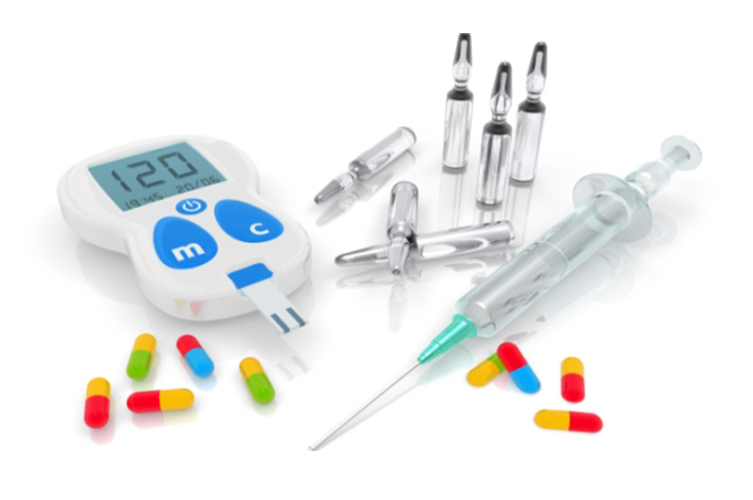worlddiabetesday
Important Lifestyle Changes For A Diabetic
Keeping your glucose levels inside the range prescribed by your specialist can be challenging. That is on account of numerous other things that roll out the increase of your glucose levels, here and there out of the blue. Nutrition: Adhering to a good diet is a foundation of a healthy living and it doesn’t matter whether you have diabetes or not. In any case, on the off chance that you have diabetes, you have to know how nourishments influence your glucose levels. It’s the kind of food you eat as well as the amount you eat is what determines how your blood glucose levels increase or decrease. A key to numerous diabetes control techniques is figuring out how to tally carbs. These are the foods that frequently have the greatest effect on your glucose levels. Also, for individuals taking mealtime insulin, it’s essential to know the measure of starches in your nourishment, so you get the correct insulin dosage. Realize what parcel size is best for each and every variation of food that you have. Have a count of calories. There are books available that has indepth details about every food and its calorie count. Try eating organic products, vegetables and whole grains. These foods are low in starches and contain essential fibers that keeps your glucose levels more steady. Converse with your specialist, medical attendant or dietician about the best sustenance decisions and the suitable adjustments of the kind of food you include in your meal. Stay away from carbonated drinks. Sugar-sweetened drinks incorporating those sweetened with high fructose corn syrup or sucrose have a tendency to be high in calories and offer little to the nutritional value that is required for your sustenance. Furthermore, on the grounds that they cause glucose to rise rapidly, it’s best to dodge these sorts of beverages in the event that you have diabetes. Work out: Physical work is another essential aspect of your efforts to control diabetes. When you work out, your muscles utilize sugar (glucose) for vitality. Customary physical movement likewise helps your body utilize insulin all the more proficiently. These elements cooperate to bring down your glucose level. The more strenuous your workout, the more drawn out the impact keeps is. Yet, even light exercises, for example, household chors, walking for an hour or so and this can drastically enhance your glucose level. Talk to your doctor and make an exercise chart and try to follow that everyday so, you can maintain regular physical activity. Talk your doctor and know which exercise is best for your condition. Check your blood sugar level from time to time. Check your glucose level some time recently, amid and after work out, particularly on the off chance that you take insulin or meds that lower blood sugar in your system. Make Sure You Drink a Lot of water to keep yourself hydrated.
6 Superfoods To Include In Your Diet For Controlling Diabetes
Diabetes is on the ascent, yet most cases are preventable and some can even be turned around. Finding a way to avert and control diabetes doesn’t mean living in hardship; it implies eating a delectable, adjusted eating routine that will likewise support your vitality and enhance your disposition. With these tips, you can in any case take delight from your suppers and at the same time fight diabetes. So, these 6 superfoods are a must for controlling diabetes: Turmeric: Turmeric has been used by us Indians since ancient times. Being a conventional Indian spice, it is used in every household as it helps digesting fats in the body. Turmeric contains an active component called Curcumin, which posseses the unique power to turn around insulin resistance, high glucose and elevated cholesterol levels, and different side effects connected to heftiness. Broccolii: Broccoli is amazing when it comes to diabetes. Similar to kale and cauliflower, it contains a compound called sulforaphane, which helps to enhance glucose control and shield veins from the cardiovascular harm that is frequently a result of diabetes. Sulforaphane additionally helps secrete the body’s natural detox components, urging compounds to transform hazardous cancer causing chemicals into useful components. Fish: Fish is rich in protein, and contains a kind of fat that controls inflammation. Fish is a great source of omega-3 and studies have concluded that unsaturated fats cause the least amount of inflammation, the very foundation that intensifies diabetes and weight issues. A diet that contains fish reduces your chances of several health conditions, particularly stroke, as an aftereffect of your diabetes. Spinach: Spinach is one of the numerous verdant green veggies that have been appeared to help with controlling diabetes. As per a recent study, Individuals who expend more than one serving a day of spinach is more likely to be the victim of the effects that arise from diabetes, contrasted with individuals who eat under half a serving every day. Spinach is rich in vitamin K, alongside a few minerals including magnesium, folate, phosphorus, potassium, and zinc. Blueberries: They contain both insoluble fibre and dissolvable fibre. It is a proven fact that the regular use of blueberries, bring down blood glucose levels. The active component in these berries is anthocyanins, a substance that fortifies the arrival of adiponectin, a hormone that manages blood glucose levels, in addition to other health benefits. Increasing our adiponectin levels can keep glucose low and increment our affectability to insulin. Walnuts: This is the most widely used nut on the planet, walnuts contain the polyunsaturated fat called alpha-linolenic corrosive, which has been appeared to lower aggravation. The L-arginine, omega-3s, fiber, vitamin E, and different phytochemicals found in walnuts and other tree nuts make them a super food that fights with not only diabetes, but coronary heart diseases and provides relief from several other diseases.
10 Important Tests for Diabetes
On the off chance that you encounter symptoms of increased thirst, frequent urination, unexplained weight reduction, increased appetite, and feel a tingling sensation in your hands or feet, chances are that you are a diabetic. Find out by the following diabetes tests. The Symptoms and effects of diabetes show up all of a sudden and are frequently the explanation behind checking glucose levels. Since the symptoms of diabetes and prediabetes appear more gradually, the side effects may not be clear to us. However, The American Diabetes Association (ADA) has prescribed some particular screening rules for the accompanying individuals: Individuals aged 45 and above are encouraged to get a blood sugar screening, and if results are normal, he is to be screened in every 3 years. Any individual with a body mass index higher than 25, paying little respect to age, pertaining to extra risk components like, hypertension, an inactive way of life, someone who has been diagnosed with PCOS, having delivered an infant who measured more than 9 pounds, a crisp background marked by diabetes in pregnancy, extremely high cholesterol levels, a past filled with coronary illness, and having a relative with diabetes. All top test for diabetes mentioned here. Top Tests for Diabetes HbA1C: This blood test shows your normal glucose level for as long as a few months. It quantifies the rate of glucose connected to haemoglobin and the protein that carries oxygen in red blood cells. The higher the glucose levels, the more haemoglobin one has with sugar attached to it. An A1C level of 6.5 percent or higher on two separate tests shows that you have diabetes. An A1C somewhere around 5.7 and 6.4 percent demonstrates prediabetes. Beneath 5.7 is viewed as normal. Fasting Blood Sugar Test: In this test your blood sample will be collected after you have observed an overnight fast. A fasting blood sugar level less than 100 mg/dL (5.6 mmol/L) is normal. A fasting blood sugar level from 100 to 125 mg/dL (5.6 to 6.9 mmol/L) is considered prediabetes. If it’s 126 mg/dL (7 mmol/L) or higher on two separate tests, you have diabetes. A Complete Blood Count (CBC): This is a blood test used to evaluate an individual’s overall health and discover a wide range of disorders, ranging from anemia, to leukemia. The CBC test measures several components and features of one’s blood, that typically includes Oxygen carrying Red blood cells, White blood cells, Hemoglobin, the protein in red blood cells that carries oxygen, Hematocrit, the proportion of plasma in an individual’s blood and Platelets, that help with clotting blood. Any abnormal increases or decreases in these cell counts as revealed in a CBC test may indicate that one might have an underlying medical condition that requires to be diagnosed further. Post Prandial Glucose Test (PPBS): This is a blood glucose test that decides the measure of a particular type of sugar, named as glucose. In this test Glucose is measured in the blood particularly after a meal. Ordinarily, blood glucose levels elevate marginally after eating a meal. This expansion causes the pancreas to discharge insulin, which helps the body in expelling glucose from the blood and storing it for providing vital energy to the body. Individuals with diabetes may not create or react legitimately to insulin, which increases their blood glucose levels. High blood glucose levels can drastically harm the eyes, kidneys, nerves, and veins. A 2-hour PPBS test measures blood glucose precisely 2 hours in the wake of eating a meal. By this point glucose has generally retreated down in healthy individuals, yet it might in any case be raised in individuals with diabetes. Subsequently, it serves as a trial for whether an individual may have diabetes, or of whether an individual who has diabetes is effectively controlling their blood glucose levels. Cholesterol Test: Diabetes drastically increases the risk of heart disease in an individual, which makes it inevitable for them to have a blood test to screen their cholesterol levels more frequently; in the off chance their cholesterol levels are high. Triglycerides: Triglycerides are a kind of fat that is typically found in the blood. When there is an increase in the levels of triglycerides, it increases the risk of coronary artery disease, especially in women. A person’s triglyceride levels are measured with a blood test along with testing cholesterol levels in the blood. Normal triglycerides are below 150. Levels above 200 are high. Normally a person’s triglyceride level increases due to: Being overweight Lack of Exercise Excessive Smoking Alcohol Genetic disorders Triglyceride levels may be lowered with a combination lifestyle changes like: Losing Weight Healthy Diet Regular Exercise Creatinine Blood Test: A creatinine blood test measures the level of creatinine in the blood. Creatinine is a waste item that structures when creatine separates. Creatine is found in your muscle. Creatinine levels in the blood can provide your specialist with data about how well your kidneys are functioning. Electrolytes: This is a blood test that measures the main electrolytes in the body which includes sodium, potassium, chloride and bicarbonate (CO2)—can be used to evaluate symptoms of heart disease and monitor the effectiveness of treatments for high blood pressure, heart failure and liver and kidney disease. Insulin Auto Antibodies (IAA): This tests detects the antibodies targeting insulin, Along with attacking beta cells, the immune system in people with type 1 diabetes also targets insulin.. C-Peptide: This test measures how much C-peptide is in the blood of an individual. Since levels of this peptide generally match insulin levels in the body, the test is mostly used to indicate how much insulin an individual’s body is producing. Normally Low levels of C-peptide and insulin usually point to type 1 diabetes.
 Home Visit
Home Visit Upload
Upload

















 WhatsApp
WhatsApp